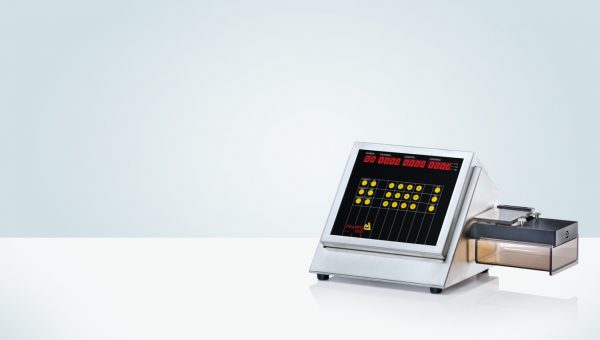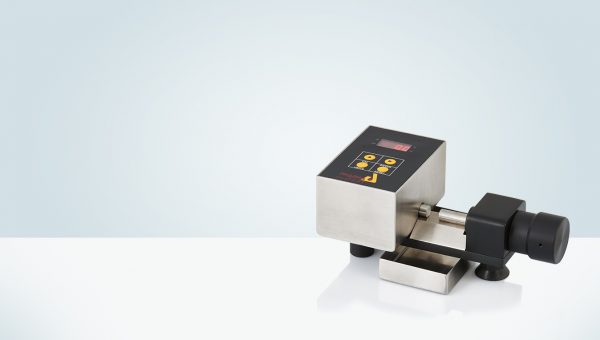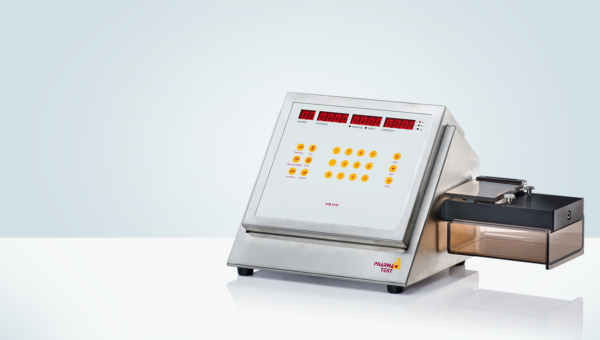PTB 111EP
PTB 111EP manual tablet hardness testing instrument with integrated printer available in different hardness ranges
PTB 111EP
Manual Tablet Hardness Testing Instrument with Integrated Report Printer
The manual tablet hardness testing instrument PTB111EP / 111EP-500 / 111EP-800 features an integrated report printer. It is a dual force mode hardness test apparatus as it can be used for either linear force or linear speed increase while tablet hardness is tested. It offers a multiple point validation procedure for the built-in digital load cell. The instrument is made in strict compliance with the EP <2.9.8> and USP <1217> Pharmacopoeia.
Test Procedure Featuring an Integrated Report Printer
Enter the nominal test information for hardness as well as a batch number via the PTB111EP / 111EP-500 / 111EP-800 keyboard. Select the unit to measure, KP (Kilopond), N (Newton) or Sc (Strong Cobb), now place the sample onto the sample dish and start the test. The driven jaw will run forward, touch and force the tablet until it breaks to measure the hardness (tablet breaking force). The result is immediately displayed and printed via the integrated report printer. Repeat this until your series has been tested, get a full print-out including each individual result, date, time, serial number of the instrument, batch number of the product tested, mean value and deviations of the test series.
The flexibility and the reproducibility of the results have made this and other models, like the PTB 311E/511E/311E-800 series become one of the most sold tablet hardness testing instruments worldwide. By using an integrated report printer, the bench space requirements to of this instrument are even lower than other instruments from the PTB series, since no additional external printer is required. Furthermore, the report printer requires less paper than a standard printer and by this helps to preserve our precious natural resources.
Operating Principle
Even in the existing USP and EP monographs there is no standard force setting or force increase mode established, but it is recommended to use a linear force increase rate of 20N/s. Different force settings usually cause problems when comparing results received by different supplier’s instruments when testing the same tablet. The hardness result is directly influenced by the contact speed and force increase rate.
Faster operated test jaw means lower reproducibility and often higher results. In order to offer the possibility to select an operating mode which will offer you similar results as the instruments you may already use, select the force mode, linear force increase or linear speed increase and select the same or similar rate. Also touch and detection force may be altered to suit the sample design specification. When the sample is touched the instrument switches to the selected mode and linear increasing rate.
Which Force Mode Should Be Selected?
For more than 18 years all Pharma Test hardness testing instruments offer the possibility to select either linear force or linear speed increase. Linear force increase is the recommended setting as it offers the most accurate control, as the rate of increase is directly controlled by the electronic load cell used to read the force. Also it is quite simple to validate the correct and linear operation as a tablet having a hardness of 100 Newton will be broken within 5 seconds if 20N/s had been set as force increase rate.
The test of “soft” tablets often requires an increase of the standard force setting; otherwise the sample gets deformed only but does not break. Linear speed increase can also be used. Here the driving speed of the motor is kept linear. Actually if the touching force is kept low there is not too much difference in results between the two systems but it is very difficult to validate the linearity of the drive speed.
Calibration and Validation
The current USP Pharmacopeia requires the force sensor of a tablet hardness testing instrument to be calibrated periodically over the complete measuring range (or the range used for measuring samples) with a precision of 1N. All Pharma Test tablet hardness testing instrument can be statically calibrated over the complete measuring range by the use of different traceable counterweights. All instruments support the checking of at least three different points during calibration to prove the linearity of the force sensor.

Furthermore, Pharma Test offers the PT-MT3 magnetic tablets to calibrate the breakpoint detection of the whole tablet hardness testing instrument (force sensor and mechanics of the instrument). All Pharma Test tablet hardness testing instruments are fully compliant to the requirements of the current USP Pharmacopeia. The PTB111EP / 111EP-500 / 111EP-800 offers a built-in calibration and validation program for the hardness test station. To validate the hardness test station the PT-MT3 magnetic tablet or different certified counterweights are used. Use the PT-MT3 to qualify the correct breakpoint detection, the PT-MT3 instrument works like a tablet, it withstands force and after “breaks”. For the two point adjustment (zero and reference) of the load cell inside the hardness station a certified reference weight of 10 kg is used. For validation purposes the use 5 up to 30kg certified weights is recommended.
All adjustment and calibration results can be printed and countersigned. To prove the linearity of the instrument, the operator can program a print-out of the force curve recorded during a test. This will show the linear increase of the adjusted force mode. Also different counterweights, like the PTB-CAL15 and PTB-CAL30 which includes 5, 10, 15kg and also 30kg or the PTB-CAL30 using 2 additional 10kg weights for total 50kg, may be placed onto the load cell or the PT-MT3 shall be used to breakpoint detection. Using the Parallel Printer Port a Dot-Matrix or PCL5 printer can be added. The RS232 COM port is used to transmit all results to software running on a computer system.
Features
- Fully USP <1217> and EP <2.9.8> compliant
- Dual force mode instrument with linear speed increase and linear force increase modes
- Steppless adjustment of the linear force or speed increase rate
- Integrated thermal printer
- Multiple point validation procedure built-in
- Programmable print-out of force increase curve
- Set to test tension strength of oblongs and caplets available
Advantages
- No external printer required, this reduces the necessary bench space
- Documentation of all results using an integrated report printer
- Report printer uses less paper compared to a standard A4 format printer
- Select either linear force or linear speed increase (dual mode selection)
- Entry of time and date
- Enter a 12 digit batch number
- Automatic re-start facility to speed up the testing sequence
- Validation and calibration program for the measurement station
- Force curve print out
- Dual point adjustment of the load cell for the hardness test station
- Multiple point validation (calibration)
- Programmable print-out of force increase curve
- Data transfer via RS-232 interface
- Hardness testing in compliance with the EP <2.9.8> and USP <1217> Pharmacopoeia
- Test program for soft gelatine capsule testing by setting up a testing distance
Technical Specifications
| Parameter | Specification |
| Hardness Testing Range | PTB111EP: 5.0 – 300.0 N ± 2 N
PTB111EP-500: 10.0 – 500.0 N ± 5 N PTB111EP-800: 10.0 – 800.0 N ± 5 N |
| Hardness Accuracy | Better than ±1 N |
| Hardness Resolution | 0.1 N |
| Measuring Units | Newton (N), Kilopond (kp) and Strong Cobb (Sc) |
| Force Mode | Selectable: linear force increase or linear speed increase |
| Force Rate
(linear force increase) |
PTB111EP, PTB111EP-500: 5 – 200 N/sec
PTB111EP-800: 10 – 200 N/sec. |
| Force Rate
(constant speed) |
5 – 200 mm/Min |
| Breakpoint Detection Range | Min. 2mm, Max. 10 mm |
| Sample Touch Force | Min. 48 digits (approx. 3N), Max. 999 digits |
| Breakpoint Detection Force | Min. 48 digits (approx. 3N), Max. 999 digits |
| Internal Printer | Thermo-Printer Miniplus-P3B, parallel, 58 mm paper width, 30 mm paper roll diameter |
| Interface | RS-232 serial, data transfer
USB PCL 3-5 type printers only by use of a LPT to USB adapter (part no. 002-0461) |
| Instrument Housing | Stainless steel (304) to meet GLP requirements |
| Power | 115 Volt AC or 230 Volt AC, 50/60 Hz |
| Current Consumption | 0,15 A at 230 V; 0,30 A at 115 V; 35 W |
| Main Fuse | 2 x T1,0 A |
| Installation Requirements | Ambient Temperature 15-35 °C
Relative Humidity 15-80 %rH Desk with at least 50 kg working load. All around the instrument at least 10 cm free distance to walls or other equipment. Free access to the mains power plug and switch. |
| Instrument Dimensions | Approx. 260 x 500 x 260 mm (Length x Width x Height) |
| Packaging Dimensions | Approx. 310 x 660 x 420 mm (Length x Width x Height) |
| Net / Gross Weight | Approx. 9,5 kg / 12,5 kg (without optional accessories) |
| Certification | All components certified to USP / EP requirements |
| CE / EMC Certification | All CE / EMC Certification provided |
| Validation | All IQ & OQ documents included |
We reserve the right to make technical changes without any prior notice.
Included in the Standard Scope of Supply
The PTB111EP / 111EP-500 / 111EP-800 comes ready to use with the following standard scope of supply:
- Standard jaw set size 4 to allow hardness test of all size and shape samples
- Broken sample collector
- 10 rolls of printer paper
- Comprehensive documentation folder including:
- User manual
- QC/DQ testing certificate
- IQ documentation
- OQ documentation
- Conformity Declaration
- CE/EMC Declaration
- Instrument logbook
Options
In addition to the standard scope of supply Pharma Test offers a broad range of accessories and options including:
- 500N (PTB 111EP-500) and 800N (PTB 111EP-800) extended force range
- Recommended spare part set
- Full range of certified validation tools available
- Tension test set to test break line force of shaped tablets






